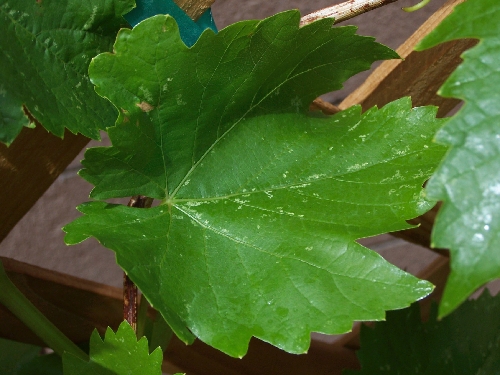Grape leaf skeletonizer appears in May
Q: Can you tell me what is wrong with the leaves on my Thompson seedless grape vine ? Are there grape leaf miners? What is the best pesticide to use to control these pests?
A: I really did not see too much to be concerned about on the top of the leaf. Make sure you look at the bottom . Some insect pests will invade the leaves from the bottom. The leaves look pretty normal to me .
However, you are getting into the season when you will get grape leaf skeletonizer, which starts in May. Keep inspecting your leaves and in the next week or two begin spraying your grape leaves with Bt, an organic pesticide.
Do this twice about 10 days apart in May. This should eliminate grape leaf skeletonizer as well as hornworm attacks. If the little bugs called leaf hoppers, which jump when you walk past your grapevine, are a problem in the summer months, then you might also apply two applications of spinosad around the same time as the Bt.
Do not mix them in the same sprayer, because I am not sure they are compatible. Make sure you spray the tops as well as the bottoms of the leaves. This is very important to get good coverage. Good luck.
Q: I purchased some heirloom tomatoes at the nursery. They got silvery/shiny areas on the back of the leaves, which turned into dry, dead spots. The plant is also dropping blossoms. What is this? I applied fungicide but do not know if this is appropriate. My homegrown tomato plants do not have this. Please let me know. I do not want my other tomato plants infected.
A: You have noticed something that I have talked about. This is concerning the quality of homegrown vegetable transplants being superior to the transplants grown by commercial growers for the mass markets.
To get transplants ready for markets, growers usually have to grow transplants in some sort of protected culture, such as greenhouses, cold frames, hot frames or hoop houses. When grown for mass markets, transplants have to be produced at the lowest cost possible to improve profit margins.
In many cases, these transplants may not be grown under the cleanest conditions, and the growing conditions also may not be the best. This means that mass market transplants can be very subject to earlier development of diseases and insect problems.
When you grow transplants at home, you can afford to start with cleaner materials and, as a consequence, have fewer insects and diseases to contend with. You also can get the exact variety you want by ordering the seed ahead of time.
Sometimes the commercial grower will apply pesticides just before shipping transplants to remove any pest problems that might be developing or pests that may already be there and make sure they are pest-free when delivered to the nursery.
Several problems can cause silvery discoloration to the leaves, including the natural silvery-green color of some tomato plants. These dead spots may or may not be related to the gray-green color of the leaves. The brown spots could be due to feeding damage by insects or a disease problem. It is hard to say exactly without seeing a fresh plant sample with the disease present or several high-quality pictures.
As far as blossom drop on tomatoes, remember that they are finicky. Temperatures too high during the day, too low at night, and irrigation that is missed on an unusually hot day when temperatures have been abnormally cool all can play a role. Tomatoes grown excluding bees for pollination may cause the flowers to abort.
If you are worried about a lack of bees, then use your electric toothbrush to vibrate the plant for better fruit set. Touching the electric vibrating toothbrush to portions of the plants close to the flowers for a few seconds may improve fruit set if bees are limited.
I would suggest you consider applying some preventive sprays to transplants brought into the garden from a nursery or garden center. This is seldom needed for homegrown transplants or from commercial growers who maintain clean facilities and planting material.
Sprays would include insecticidal soap applications every few days, spraying Neem oil and some other organic sprays specifically for vegetables.
In the future, I would recommend growing your own transplants, if you can, and you will see fewer problems such as those you are mentioning. Local producers of vegetable transplants can be found; they are usually higher priced but cleaner and with fewer problems.
Q: I have two sago palms in my front yard. One has nice growth in the center and the other does not. I learned that all the landscaping was put in at the same time, so I'm sure they are the same age. Any ideas on why this might happen or how I can encourage growth in the second one.
A: Both look fine. They are at different stages of growth; one has its new growth, upright and lightly colored (since it is new growth), and the other has not grown from the central bud yet, so there is no new upright growth at the center.
Sago palm (a misnomer since it is not a palm) grows its new fronds from the central bud in the same way palms do. If one of the sagos is in a brighter, sunnier (warmer) location than the other one, then it will show new growth earlier than the one in the colder spot.
Plants in shadier spots usually have fronds that are larger and more succulent and luxurious in appearance.
To me, the ones in the shade look like they need more light and are kind of spindly in appearance, but that is my view.
Bob Morris is a horticulture expert living in Las Vegas; he is on special assignment in the Balkh Province, Afghanistan, for the University of California, Davis. Visit his blog at xtremehorticulture.blogspot.com.

















